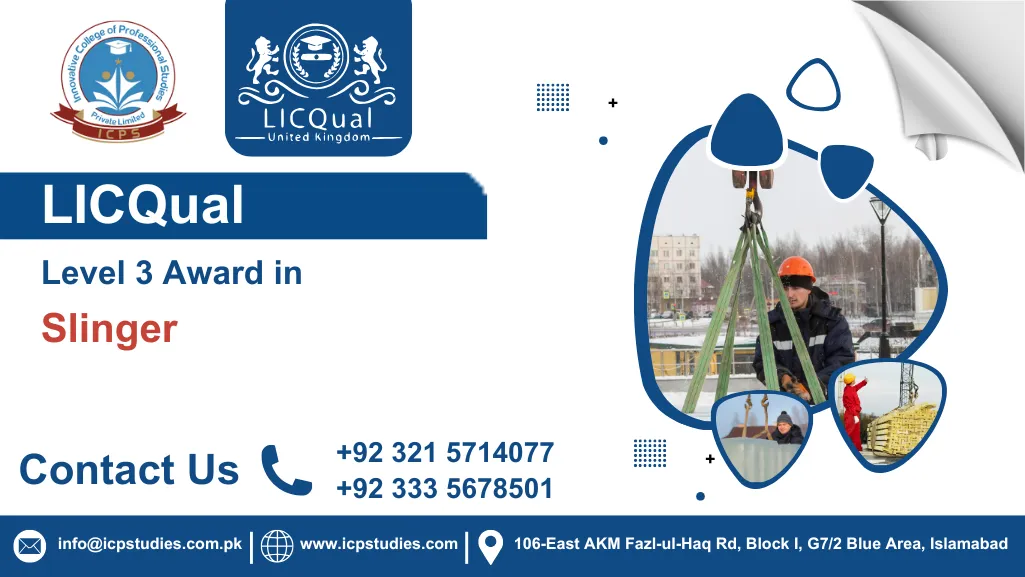The LICQual Level 3 Award in Slinger is a specialized certification designed to equip learners with the essential knowledge, skills, and practical competence required to work safely and effectively as a slinger in lifting operations. This award focuses on the critical role of the slinger in ensuring that lifting activities are carried out in compliance with safety standards, industry regulations, and best practices. Learners will gain a thorough understanding of how to prepare, guide, and control loads during lifting operations, while also developing the ability to communicate effectively with crane operators and other team members. The course emphasizes the importance of precision, safety awareness, and responsibility, making it highly relevant for those working in construction, engineering, logistics, and industrial environments.
The program provides a comprehensive overview of slinging practices, including the selection and inspection of lifting equipment, the application of safe working loads, and the identification of potential hazards in lifting operations. Learners will explore the principles of load balance, weight distribution, and secure attachment methods, ensuring that they can manage lifting tasks with confidence and competence. Practical training is a key component of the award, allowing participants to apply theoretical knowledge in real‑world scenarios. By engaging in hands‑on exercises, learners will develop the ability to assess risks, make informed decisions, and contribute to the safe and efficient completion of lifting operations.
This award also highlights the professional responsibilities of a slinger, including adherence to health and safety legislation, compliance with organizational policies, and the promotion of a safety‑first culture in the workplace. Learners will be encouraged to reflect on their role within a lifting team, recognizing the importance of clear communication, teamwork, and accountability. Upon successful completion, participants will achieve the LICQual Level 3 Award in Slinger, a certification that demonstrates their competence and commitment to safe lifting practices. This award can also serve as a foundation for pursuing further certifications and diplomas in lifting operations, construction safety, and industrial training, supporting career progression and professional recognition within the sector.
All About LICQual Level 3 Award in Slinger
Course Overview
The LICQual Level 3 Award in Slinger is a focused certification designed to provide learners with the essential knowledge and practical skills required to operate safely and effectively in slinging operations. This award emphasizes the critical role of the slinger in lifting activities, ensuring that loads are prepared, guided, and controlled in compliance with industry standards and workplace safety requirements. With a strong balance of theory and practice, the course equips participants to work confidently in construction, engineering, logistics, and industrial environments where lifting operations are a daily necessity.
The qualification is structured into 6 units, each carefully designed to cover key aspects of slinging practice. Learners will explore topics such as equipment selection and inspection, safe working loads, hazard identification, communication with crane operators, and teamwork in lifting operations. Each unit builds progressively, ensuring that learners develop both technical competence and professional awareness. The award carries a total of 6 credits, reflecting its concise yet comprehensive scope, and provides a clear framework for learners to demonstrate their competence in line with recognized industry expectations.
With a Guided Learning Hours (GLH) requirement of 18, the program is designed to be intensive and efficient, making it accessible for working professionals who require certification without lengthy study commitments. The course delivery combines classroom-based learning with practical exercises, allowing participants to apply theoretical knowledge in real-world scenarios. This approach ensures that learners not only understand the principles of safe slinging but also gain hands-on experience in managing lifting tasks, assessing risks, and ensuring operational safety.
By completing the LICQual Level 3 Award in Slinger, learners will achieve a certification that validates their competence and commitment to safe lifting practices. This award is highly relevant for individuals seeking to enhance their professional credibility and meet workplace requirements in industries where lifting operations are integral. It also provides a strong foundation for pursuing further certifications and diplomas in lifting operations, construction safety, and industrial training, supporting career progression and professional recognition within the sector.
To ensure learners are suitably prepared for the LICQual Level 3 Award in Slinger, applicants must meet the following requirements:
- Age Requirements Learners must be at least 18 years old, reflecting the maturity and responsibility required for safe participation in lifting operations.
- Educational Requirements A basic educational background is required, ideally supported by related vocational certificates or diplomas such as Health and Safety Awareness, Construction Skills Certification, or Basic Lifting and Rigging Techniques.
- Language Proficiency Learners should demonstrate proficiency in English or the language of instruction, with the ability to read, write, and communicate effectively in technical and safety contexts.
- Work Experience Prior exposure to construction, engineering, logistics, or industrial environments is recommended, particularly in roles involving lifting operations, equipment handling, or safety compliance.
These entry requirements ensure that learners enrolling in the LICQual Level 3 Award in Slinger have the maturity, foundational knowledge, and practical awareness necessary to succeed in the program and apply their skills effectively in workplace settings.
The ideal learner for the LICQual Level 3 Award in Slinger is someone who demonstrates responsibility, practical awareness, and a strong commitment to safety in lifting operations. This learner is motivated to enhance their competence, contribute to workplace safety, and gain recognition through professional certification.
Professional Background
- Works within construction, engineering, logistics, or industrial environments
- Has prior exposure to lifting operations or equipment handling
- Familiar with workplace safety policies and procedures
- Engages with teams and supervisors in operational settings
- Demonstrates responsibility in managing tasks safely and efficiently
Educational Readiness
- Possesses a basic educational background with vocational training or certificates
- Comfortable with technical learning and safety-related study materials
- Able to interpret operational guidelines and apply them in practice
- Prepared to balance theoretical learning with hands-on application
- Shows readiness to progress into structured certification programs
Personal Attributes
- Committed to promoting safety and compliance in workplace operations
- Displays confidence, focus, and attention to detail in practical tasks
- Demonstrates teamwork and effective communication skills
- Open to feedback and willing to adapt methods for improvement
- Upholds integrity, accountability, and professionalism in all duties
Practical Potential
- Interested in developing competence in slinging and lifting operations
- Motivated to apply safe working practices consistently
- Willing to participate in practical exercises and real-world scenarios
- Capable of managing risks and making informed decisions under pressure
- Seeks to contribute to efficient and safe lifting operations in the workplace
Career Aspirations
- Aims to gain recognition as a certified slinger in construction or industrial sectors
- Seeks opportunities to enhance employability and workplace credibility
- Interested in progressing into supervisory or safety-focused roles
- Motivated to build a career in lifting operations and related fields
- Committed to continuous learning and professional development
The ideal learner for this award is someone who combines practical experience, personal commitment, and professional ambition, with the goal of becoming a competent and certified slinger who contributes to safe and efficient lifting operations across diverse industries.
Study Units
- Advanced Slinging and Signalling Operations
- In-depth Risk Assessment for Complex Lifting
- Complex Equipment Handling
- Environmental and Hazard Awareness
- Problem Solving and Troubleshooting in Lifting
- Comprehensive Knowledge of Industry Standards
Learning Outcomes
By the end of this course, learners will be able to demonstrate advanced competence in slinging operations, risk assessment, equipment handling, hazard awareness, problem-solving, and compliance with industry standards. Each unit is designed to build practical skills and theoretical knowledge, ensuring learners are fully prepared to contribute to safe and efficient lifting operations in diverse workplace environments.
Advanced Slinging and Signalling Operations
- Perform advanced slinging and signalling techniques for a wide range of complex and irregular loads.
- Apply correct rigging and slinging methods to safely manage heavy, oversized, or unconventional loads.
- Execute advanced hand signals and communication protocols to ensure effective coordination with crane operators and lifting teams.
- Adjust slinging techniques based on environmental conditions, load shape, and weight distribution to maintain safety.
- Manage lifting operations that involve multiple slingers and operators working collaboratively.
In-depth Risk Assessment for Complex Lifting
- Conduct detailed risk assessments for complex lifting operations, identifying hazards such as instability, environmental risks, or equipment failure.
- Develop and implement effective risk control measures to mitigate identified hazards.
- Evaluate risks in multi-stage lifts, heavy lifting, or operations involving cranes and specialized equipment.
- Assess external factors such as weather, site conditions, and equipment limitations that may affect lifting safety.
- Adjust lifting plans based on risk analysis to ensure compliance with safety standards.
Complex Equipment Handling
- Select, inspect, and operate complex lifting equipment including heavy-duty cranes, winches, and multi-point rigging systems.
- Understand technical specifications and limitations of different types of lifting equipment.
- Safely manage the setup, operation, and dismantling of specialized lifting tools and machinery.
- Identify faults and potential failure points in equipment and take corrective actions to ensure safety.
- Maintain and store lifting equipment correctly to extend operational life and ensure compliance with safety requirements.
Environmental and Hazard Awareness
- Recognize and assess environmental hazards such as adverse weather, unstable ground, or restricted site access.
- Develop strategies to manage environmental challenges while maintaining operational safety.
- Understand how environmental factors impact load stability and lifting techniques.
- Implement hazard control measures to protect personnel, equipment, and the surrounding environment.
- Ensure compliance with environmental and safety regulations during lifting operations in varied conditions.
Problem Solving and Troubleshooting in Lifting
- Apply critical thinking and problem-solving skills to resolve challenges during complex lifting operations.
- Identify issues such as equipment malfunction, load imbalance, or communication breakdowns and develop quick solutions.
- Adapt lifting plans and techniques in response to unexpected complications or site-specific challenges.
- Communicate effectively with the lifting team to troubleshoot problems and maintain smooth operations.
- Develop contingency plans to handle unforeseen obstacles and ensure safety throughout the lifting process.
Comprehensive Knowledge of Industry Standards
- Demonstrate a thorough understanding of industry standards, regulations, and safety requirements for slinging and lifting operations.
- Apply national and international lifting standards to ensure compliance in all aspects of operations.
- Stay updated on industry best practices and integrate them into operational procedures.
- Understand the roles and responsibilities of all parties involved in lifting operations according to industry guidelines.
- Ensure lifting operations meet legal, safety, and environmental regulations, contributing to safe and effective outcomes.
Together, these learning outcomes ensure that learners completing the course will possess advanced technical skills, strong safety awareness, and a comprehensive understanding of industry standards. Graduates will be fully prepared to carry out complex lifting operations with confidence, professionalism, and a commitment to maintaining the highest levels of safety and efficiency in the workplace.
FAQs About LICQual Level 3 Award in Slinger

